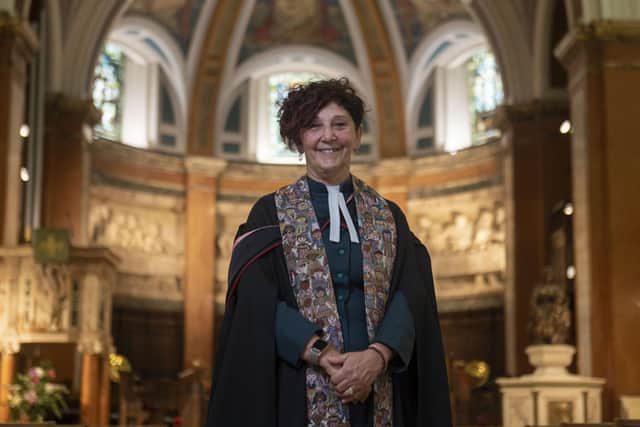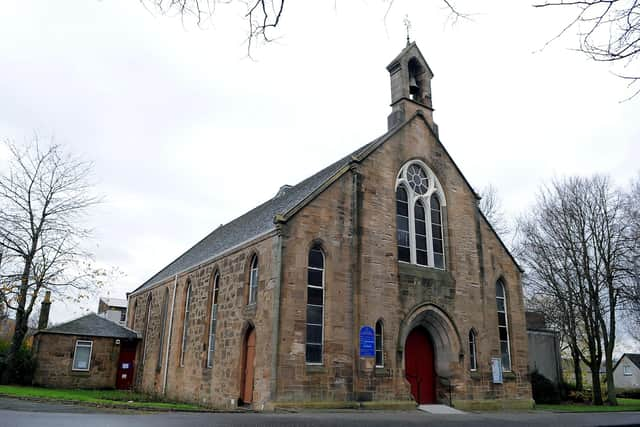Church closures are painful but essential, says Kirk moderator
and live on Freeview channel 276
A radical restructuring of the nation’s largest denomination is taking place against a backdrop of falling memberships and tight finances but the Rt Rev Sally Foster-Fulton, moderator of the Church of Scotland’s General Assembly, insists the process is also a chance to look to the future.
“It's a challenge, but it's also a real opportunity to reimagine ourselves and the Church of Scotland, and to let go of some of the baggage that’s held us down,” she said, speaking at her official residence in Edinburgh’s West End.
Advertisement
Hide AdAdvertisement
Hide Ad“Too many buildings is an energy-sapper. It's a lot of energy to maintain a building, and if you don't need it, and you can come together and work more effectively, why wouldn't you? To embrace the challenges is something I'm keen we do. Not to deny them – not ever to deny them, because I think that's naive, but also not to let that direct our fear.”


One of the Falkirk area church buildings in danger of being closed if a presbytery proposal goes ahead, is Camelon Parish Church – the congregation which was the first charge for the Moderator when she entered the ministry.
The draft proposals for this area would eventually see only one church to serve Falkirk and Camelon; two for Denny; one for Grangemouth; and one for Airth and Larbert. Many of the churches where people have worshipped for generations would then be deemed surplus to requirements.
Across Scotland membership of the Kirk has fallen from 1.3 million in the late 1950s to around 283,600, with only around 60,000 regularly attending worship on a Sunday.
Advertisement
Hide AdAdvertisement
Hide AdBut Ms Foster-Fulton said there had never been a “heyday” for the church. Challenges have always existed.


She also argued the Church of Scotland’s history means it simply has too many buildings. After the Disruption of 1843, the newly-formed Free Church of Scotland, which had broken away from the Kirk, set about building its own infrastructure. Much of this then passed to the Church of Scotland when the schism was largely healed.
“I do know, going back and looking at our history, that post the Disruption, when the churches came back together, we had double the buildings that we need,” Ms Foster-Fulton said. “We have a lot of church buildings. So you've got to put that in perspective. We're not talking about a space where we were struggling to have places before – we have too many; we always have."
Scotland’s Churches Trust fears as many as 700 could close by the end of this decade. “We estimate that between 350 and 400 buildings will close over the next few years,” the charity’s director, Dr D. J. Johnston-Smith, told The Scotsman in November. “That’s what we can extract from presbytery plans that have been published or that have been leaked to us. But as well as that, we expect a similar number will close by the end of the decade. So across all denominations, we’re looking at 700 churches closing by 2030. That’s a massive change for the country.”
Advertisement
Hide AdAdvertisement
Hide AdMs Foster-Fulton, who took a sabbatical from her role as the head of Christian Aid to take on the 12-month moderator position, argues there is a difference between buildings closing and churches closing.
"What I would also say, though, is I think it's important that we make sure that where those buildings have been and are community assets, and community spaces, that they are reimagined respectfully and we look for ways to make sure that they continue to be an asset in that community,” she added.
"So, absolutely, is it a challenge? Of course it is. Is it painful for people whose church life has been surrounded by that physical space? Yes, it is.
"But I think we also are pragmatic enough to realise that if we are going to continue to make an impact in the communities we serve, that we have to address the number of buildings. We have to address the energy, the finance, the carbon footprint that those buildings represent, and do that honestly and effectively and transparently. And it is something that we have not addressed early enough and so we're having to do it. It's a tough call, but it's essential that we do it."
Advertisement
Hide AdAdvertisement
Hide AdMany fear the closure of churches will lead to the loss of vital community space for groups such as the Scouts, the Boys’ Brigade and Alcoholics Anonymous. But Ms Foster-Fulton said decisions are not being taken in a vacuum.
"Those conversations are happening, so that people feel they've got ownership of that space,” she said. “It isn't just being done in a vacuum. Making sure the buildings that are those community spaces, that are fit for purpose, that are engaging, are the ones we retain. That the ones that can be used as different community spaces, that that opportunity is explored thoroughly."
It’s about making the Church of Scotland “fit for purpose, ready to continue to do what we do”, she said.
The Kirk is also struggling with a shortage of ministers. Ms Foster-Fulton suggested more flexibility could help tackle this. “The model has been, for a long, long time, full-time, ordained clergy,” she said. “What we’re looking at now are different ways that people can serve.”
Advertisement
Hide AdAdvertisement
Hide AdThe moderator said: "We are facing a very challenging time everywhere, and the church is not immune. I think those challenges mean we need to be more determined, because what we're here for is service, and we have a lot to offer.”
The property listings on the Church of Scotland’s website betrays the extent of the disposals already taking place.
In November, some 56 properties were advertised for sale. Some 23 were church buildings, but the total included manses, halls, plots of land and residential properties. Last year, the church approved 83 property sales, bringing in more than £13.8 million.
Those properties on the market include several churches with notable national histories, such as the A-listed Old High Church in Inverness, where Jacobite prisoners were executed in the churchyard in the aftermath of the Battle of Culloden.
Advertisement
Hide AdAdvertisement
Hide AdAlso listed is the St Columba Gaelic Church in the heart of Glasgow city centre, a spectacular A-listed Gothic style building known as the ‘Highland Cathedral’.
While the Kirk’s recently reorganised presbyteries were asked to finalise their mission plans by the end of last year, work to ratify the closures remains ongoing.
However, the Presbytery of Forth Valley and Clydesdale which was formed from the former Presbyteries of Falkirk, Hamilton and Lanark, is well behind schedule and has still to finalise its plan.
The draft was presented to members at the end of September but then scheduled meetings for September 28 and October 2 were cancelled at short notice with the mission plan action group asked to look again at their proposals and to provide more details.
Advertisement
Hide AdAdvertisement
Hide AdOne of the proposals for the heart of Falkirk, Trinity Church and Camelon would be united with the Camelon church and neighbouring Dorrator Road halls closed.
Previously, Rev. Bryan Kerr, depute clerk to the presbytery, said: “A draft was presented to presbytery in September and presbytery agreed to instruct the mission plan action group to provide further information to congregations on the outcomes provided within the draft plan which remains the basis for discussion.
"At this stage there is no firm timescale as to when the plan will be presented for discussion and approval of presbytery.
"In the meantime congregations were encouraged to work together in planning for worship and mission.”
